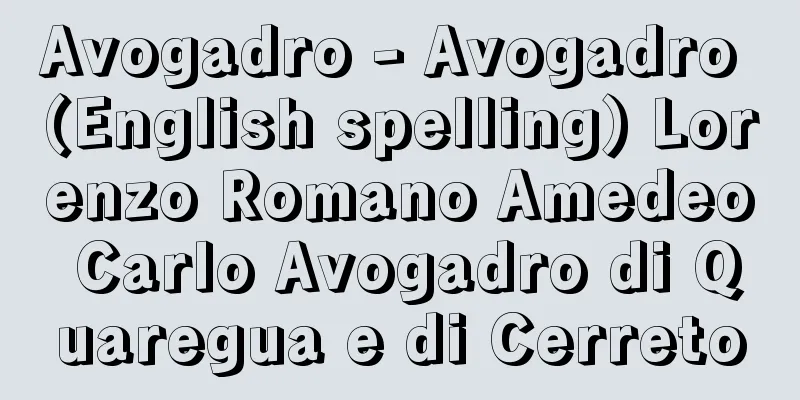Avogadro - Avogadro (English spelling) Lorenzo Romano Amedeo Carlo Avogadro di Quaregua e di Cerreto

|
Italian physicist and chemist. Born in Turin near France on August 9, he died there on July 9, 1856. His father was a famous lawyer who held a key position in the Kingdom of Sardinia. Avogadro also studied law, receiving a doctorate in canon law in 1796. He then self-taught himself in mathematics and physics while practicing law, and published papers on electricity and other subjects. As a result, he was hired as an assistant professor at a boarding house at the University of Turin in 1806, and in 1809 became professor of positivist philosophy at the Royal College of Vercelli near Turin. In 1820, he became professor of the newly established Department of Mathematical Physics at the University of Turin, and served in that position until his retirement in 1850, except for a decade when the department was closed for political reasons (from the end of 1822) and a period of two years (1830-1833) when mathematician Cauchy became professor. He also participated in government councils such as the Committee of Weights and Measures. Although Avogadro was a pious, gentle and friendly man, and fluent in foreign languages (he wrote many papers in French), he was almost unknown in the academic world both in Japan and abroad. He studied the scientific topics of his time, such as electricity, chemistry (such as the acid-alkali hierarchy), thermology (such as specific heat and thermal expansion of gases), and atomic volume. He also achieved results such as the finding that atomic volume is large for electropositive elements, but in his later years he tended to be isolated, relying on his earlier work. In particular, Avogadro's law, which he developed in his "An Essay on the Determination of the Relative Masses of the Particles of Elements, and of Their Composition Ratios," published in the French journal "Journal of Physics" in 1811, was ahead of its time and received little attention until Cannizzaro presented a research paper based on it at the International Congress of Chemistry in Karlsruhe in 1860. In this paper, Avogadro based Gay-Lussac's law of gas reactions on the principles of Dalton's atomic theory, and attempted to further develop atomic theory itself. Gay-Lussac's law states that the volumes of reacting gases are always in a simple integer ratio, and suggests that there is also a simple integer relationship for the number of particles. Avogadro first puts forward the first hypothesis that "the number of particles in all equal volumes of gas is always equal." As a result, "the ratio of particle masses is equal to the ratio of isothermal and isobaric gas densities, and the relative number of particles in a compound is given by the volume ratio of the gases that produce it." For example, the particle mass ratio of oxygen and hydrogen is 15.074 to 1, and "water is formed from the combination of two oxygen particles and one hydrogen particle." Therefore, since the number of water particles is the same as the number of hydrogen particles, their volumes should be equal. However, this is not the case in water, or in general. To explain this fact, he puts forward an ingenious second hypothesis. "The particle of an elementary gas does not consist of a single particle, but of a number of particles", and "when it combines with particles of other substances to form composite particles, the resulting particle splits into two or more particles". A single split doubles the volume, a second split quadruples it. This in turn shows that the original particle of the elementary gas was composed of half particles and quarter particles combined together. He thus established that gaseous particles such as hydrogen, oxygen, and nitrogen are diatomic molecules, and calculated the relative masses of the molecules of other elements and compounds to the hydrogen molecule. Later in this paper and in a series of subsequent papers, he extended this analysis to many elements and compounds, including solids, and revised Dalton's results. Despite the publication of similar results by the Frenchman Ampère in 1814, the law was ignored for so long that there are various explanations: the description was speculative and difficult to understand; the use of the term "molecule" with several poorly defined adjectives; the assumption of the division of what were thought to be atoms and vice versa, the unlikely combination of similar particles; the fact that atomic theory was not yet relevant for the development of chemistry; Avogadro's obscurity and isolation, and his differing ideas from those of Dalton, among others. The number of particles in one mole of a substance was later measured, and this value is now called Avogadro's constant to honor his achievement. [Yoshihito Hijioka] "The Origin of Modern Science: Physics Volume I" edited by Hiroaki Ohno (1974, Hokkaido University Press) [References] | | | | | |Source: Shogakukan Encyclopedia Nipponica About Encyclopedia Nipponica Information | Legend |
|
イタリアの物理学者、化学者。8月9日フランスに近いトリノに生まれ、1856年7月9日同地で没した。父は有名な法律家で、サルデーニャ王国の要職にあった。アボガドロも法律の教育を受け、1796年に教会法の博士号を得た。その後、法律実務に携わりながら数学や物理学を独学で修得し、電気などに関する論文を発表。この結果1806年トリノ大学の一学寮の助教師に採用され、1809年にはトリノに近いベルチェッリの王立専門学校の実証哲学教授となった。1820年には、トリノ大学に新設された数理物理学講座の教授となり、途中、政治的理由によって講座が閉鎖された10年間(1822年末から)と、数学者コーシーが教授となった2年余(1830~1833)を除いて、1850年の引退までその職にあった。また度量衡委員会など政府の審議会に関与した。 アボガドロは敬虔(けいけん)で穏やかなじみな人物で、外国語が堪能(たんのう)(フランス語の論文が多い)であったにもかかわらず、国内外の学界においても無名に近かった。彼は、電気学、酸・アルカリ序列などの化学、比熱や気体の熱膨張などの熱学、原子容など、当時の科学界の課題を研究した。そして、原子容は電気的陽性の元素では大きいというような成果もあげたが、晩年には初期の自分の仕事に依拠することが多く、孤立の傾向があった。とりわけ1811年にフランスの『物理学雑誌』に発表した『元素粒子の相対質量およびそれらの化合比の決定方法に関する試論』で展開した「アボガドロの法則」は、時代に先んじていたこともあり、1860年のカールスルーエでの化学国際会議においてカニッツァーロがこれに基づいた研究発表をするまではほとんど注目を浴びなかった。 アボガドロはこの論文において、ドルトンの原子論の原理に基づき、ゲイ・リュサックの気体反応の法則を基礎づけるとともに、原子論そのものをより発展させようとした。ゲイ・リュサックの法則は、反応する気体の容積はいつも簡単な整数比にあるというもので、粒子数に関しても簡単な整数関係があることを示唆していた。アボガドロはまず「すべての等容積の気体中の粒子数はつねに等しい」という第一の仮説を提出する。この結果「粒子質量の比は等温等圧の気体密度の比に等しく、一つの化合物中の粒子の相対数は、それを生成する気体の容積比によって与えられる」ことになる。たとえば、酸素と水素の粒子質量比は15.074対1であり、「水は酸素2、水素1粒子の結合から生じる」。そうすると、水の粒子数は水素の粒子数と同一であるから、それらの容積は等しいはずである。ところが、水の場合にも、一般にも、そうはならない。この事実を説明するために彼は独創的な第二の仮説を提出する。「単体気体の粒子は単一の粒子からなってはおらず、ある数の粒子からなっている」。そして、それが「他物質の粒子と結合して複合粒子をつくるとき、生成粒子は二つあるいはそれ以上に分裂する」。分裂が一度おこれば、容積は2倍、二度なら4倍になる。このことは逆に、もとの単体気体の粒子がそれぞれ半粒子、4分の1粒子どうしの結合体であったことを示す。こうして彼は、水素、酸素、窒素など気体元素粒子は二原子分子であることを主張し、水素分子に対するほかの元素や化合物分子の相対質量を算定した。この論文の後半や後の一連の論文で彼は固体を含む多数の元素や化合物にこの分析を拡張し、ドルトンの結果を修正した。 1814年にフランスのアンペールが似た結果を発表したにもかかわらず、この法則が長い間無視されたことについてはさまざまな見解があり、叙述が思弁的で難解であること、定義のはっきりしないいくつかの形容詞のついた「分子」という語が用いられたこと、原子と考えられていたものの分割とその逆のありそうもない同種粒子の結合が想定されていたこと、原子論は化学の発展にとってまだ不用であったこと、アボガドロが無名で孤立しており、ドルトンの考えと異なったこと、などがあげられている。 1モルの物質中の粒子数はのちに測定され、現在その値をアボガドロ定数とよんで彼の業績をたたえている。 [肱岡義人] 『大野陽朗監修『近代科学の源流 物理学編Ⅰ』(1974・北海道大学図書刊行会)』 [参照項目] | | | | | |出典 小学館 日本大百科全書(ニッポニカ)日本大百科全書(ニッポニカ)について 情報 | 凡例 |
<<: Avogadro's Number - Avogadro's Number
Recommend
Dysdercus singulatus (English spelling) Dysdercus singulatus
…[Hasegawa Jin]. … *Some of the terminology that ...
Kumihama [town] - Kumihama
A former town in Kumano County, on the northwester...
Shoulder joint
The joint that connects the scapula and humerus co...
"Azuma Kagami" - Azuma Kagami
…Also written as Toukagami. A history book compil...
Myochin - Myochin
A school of armor makers. According to the "...
Fulgora watanabei (English spelling) Fulgorawatanabei
...These protrusions have been thought to be lumi...
Aspirin-like drugs - Aspirin Yattakubutsu
...However, the trust in quinine's antipyreti...
Encephalartos villosus
A tree of the Cycadaceae family native to South Af...
Pulcinella
…But we must not forget his companions and descen...
Brückner cycle
The Brueckner cycle was proposed by German climato...
Exhaust brake
Automobile brakes close the exhaust pipe to incre...
Funahashi [village] - Funahashi
A village in Nakaniikawa County, central Toyama Pr...
Sjögren syndrome
…This also causes the salivary glands to atrophy,...
Taka
[1] [Prefix] ① Used with words that refer to a per...
Dunedin
A port city in the Otago region in the southeast o...


![Amino [town] - Amino](/upload/images/67cad8ea98719.webp)






